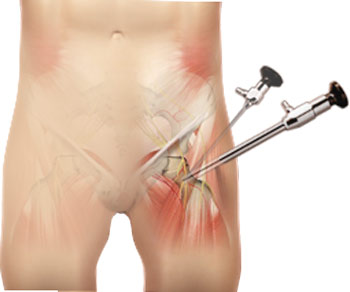
Hip arthroscopy is surgery that is done by making small cuts around your hip and looking inside using a tiny camera. Other medical instruments may also be inserted to examine or treat your hip joint.
Hip arthroscopy is a minimally invasive surgical procedure performed through 2 or 3 small 5-10 mm incisions (i.e., key hole surgery), using an advanced HD camera and special instruments to visualise and work inside and around the hip joint. A specially designed hip traction table is used to allow access into the hip joint.
The frequency of Hip Arthroscopies has been increasing explosively over the past years, leading to a hugely improved technique and greater understanding of the arthroscopic anatomy of the hip joint. Arthroscopic hip procedures can successfully treat conditions previously unrecognized or only treatable by open procedures. Improvements in technology have made the procedure accessible and reproducible. Arthroscopy for intra-articular conditions and endoscopy for periarticular pathologies continue to evolve. With the increased understanding of hip pathology and the onset of new concepts such as femoroacetabular impingement, the need for an arthroscopic access not only to the central compartment of the hip but also to the periphery became evident.
Hip Arthroscopy is one of the most rapidly evolving arthroscopy techniques. It combines the benefits of a Minimally Invasive procedure and a short rehabilitation period. Improved instrumentation and technical skills have advanced our ability to accurately diagnose and treat various conditions. The role of this procedure continues to evolve with new indications that might change the outcome of degenerative joint disease of the hip joint.
Hip arthroscopy is indicated for both traumatic and atraumatic intra and extra-articular conditions. Femoroacetabular impingement (FAI) is increasingly recognized as a disorder that can lead to progressive articular chondral and labral injury. A variety of arthroscopic techniques allows the treatment of labral and acetabular rim pathology as well as peripheral compartment femoral head-neck abnormalities. It is now recognized that labral tears that were traditionally treated with simple debridement are often associated with underlying FAI.
Hip arthroscopy is also being used for surgery to the structures surrounding the hip as snapping hip syndromes, greater trochanteric pain syndrome, and arthroscopic repair of abductor tendon tears. Better understanding of the arthroscopic anatomy, improved operative techniques, lowered complication rate and objective outcome measuring tools will further define the optimal role of hip arthroscopy and improve its outcome.